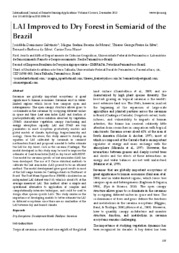LAI Improved to dry forest in Semiarid of the Brazil.
LAI Improved to dry forest in Semiarid of the Brazil.
Autoria: GALVÍNCIO, J. D.; MOURA, M. S. B. de; SILVA, T. G. F. da; SILVA, B. B. da; NAUE, C. R.
Resumo: Savannas are globally important ecosystems of great significance to human economies. Savannas exist in water-limited regions which forces tree canopies open and heterogeneous. The open canopy structure allows grass to co-dominate in the savannas by occupying different niches in space and time. Leaf area index (LAI) and fraction of photosynthetically active radiation absorbed by vegetation (FPAR) characterize vegetation canopy functioning and energy absorption capacity. LAI and FPAR are key parameters in most ecosystem productivity models and global models of climate, hydrology, biogeochemistry and ecology. Given the above, this study aimed to develop an equation of LAI calibrated by savannah in semiarid northeastern Brazil and proposed a model to better estimate the LAI for dry forest, such as the savanna (Caatinga). The model developed in this study may be used to improve the estimates of Leaf Area Index [LAI] in dry forest with NDVI. One model for savanna-specific of leaf area index (LAI) has been developed. The use of S Curve statistical methods to calibrate the leaf area index (LAI) proved to be an efficient method. The model development gives good results in most of the LAI range known for Caatinga stands in Northeast of Brazil. The Root Mean Square Error (RMSE) calculated on an independent LAI dataset was 0.10, which is about 6% of the average measured LAI. This method offers a simple and operational alternative to application of complex and computationally intensive techniques, and could be used to design other species-specific LAIs. This study reinforces the importance of developing models to better estimate the LAI in different ecosystems since there are no similarities of the LAI between dry and humid climate.
Ano de publicação: 2013
Tipo de publicação: Artigo de periódico
Unidade: Embrapa Semiárido
Palavras-chave: Caatinga, Ecossistemas secos, Fieldspec, LAI, Modelo de desenvolvimento, Natural resource, Recurso natural, Savanas, Sensoriamento remoto
Observações
1 - Por padrão são exibidas publicações dos últimos 20 anos. Para encontrar publicações mais antigas, configure o filtro ano de publicação, colocando o ano a partir do qual você deseja encontrar publicações. O filtro está na coluna da esquerda na busca acima.
2 - Para ler algumas publicações da Embrapa (apenas as que estão em formato ePub), é necessário ter, no celular ou computador, um desses softwares gratuitos. Sistemas Android: Google Play Livros; IOS: iBooks; Windows e Linux: software Calibre.
Acesse outras publicações
Acesse a Base de Dados da Pesquisa Agropecuária (BDPA) para consultar o acervo completo das bibliotecas da Embrapa.

